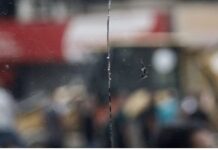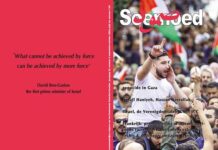Annie Sparrow
Foreign Policy / August 30, 2024
The country’s unvaccinated ultra-Orthodox population is at risk of contracting the disease, unless Netanyahu agrees to a prolonged cease-fire to allow mass vaccination.
Gaza’s recently confirmed polio outbreak is a barometer of the catastrophic public health conditions created by the Israeli military—but what many Israelis don’t realize is that the systematic assault by the Israel Defense Forces (IDF) on health care and public health infrastructure in Gaza has now come back to haunt them.
It has placed hundreds of thousands of Israelis at risk of contracting an ancient virus that strikes suddenly, paralyzing limbs and even sometimes lungs. It is so contagious that each afflicted person means several hundred others are simultaneously and invisibly spreading this incurable disease.
Although polio has been eradicated in most developed nations, Israel has particular reason to be concerned about the disease. The country has at least 175,000 vulnerable children—the offspring of the ultra-Orthodox, or haredim, who are notorious for their opposition to vaccinations.
Because the haredim comprise 17 percent of Israel’s Jews and Prime Minister Benjamin Netanyahu needs their support to remain in power, his government has exempted hundreds of thousands of haredim from Israel’s immunization program against polio as well as measles, mumps, rubella, pertussis and HPV, influenza, and COVID-19—despite the threat to domestic and global health from these vaccine-preventable diseases.
That decision, coupled with his stubborn refusal to negotiate a permanent cease-fire in Gaza, has now put Israel’s unvaccinated at risk of contracting polio.
Thursday’s announcement that Israel will allow limited combat pauses in Gaza for vaccination at designated sites is insufficient to prevent ongoing spread of the deadly virus because parents will be required to bring their children to those sites while combat elsewhere in Gaza rages; most parents simply won’t risk it. That fighting also makes impossible the kind of active outreach by healthcare workers among Gaza’s displaced population needed to obtain the near-universal vaccination required to stop the outbreak.
Shortly after polio was detected in Gaza’s sewers, the Israeli government began offering vaccinations to troops returning from Gaza. These optional shots protect soldiers from contracting polio but not from taking it back to Israel, effectively turning them into dangerous vectors of this incredibly contagious disease.
Most Israelis have largely tuned out the suffering of Palestinians caused by Israeli bombs, but the potential for the spread of a deadly disease to their own children could finally get their attention.
The risk of another polio outbreak in Israel also provides a strong incentive for Netanyahu to agree to regular prolonged humanitarian pauses to allow systematic mass vaccination to proceed in Gaza, where efforts have lapsed during the war. That could also lay the groundwork for a lasting cease-fire.
More than 10 months of Israeli bombardment has destroyed Gaza’s water sources and sanitation systems and forced almost 2 million people from their homes into crowded camps. The humanitarian blockade imposed by Israeli authorities has withheld essential nutrition, critical medicines, and lifesaving public health technology. Meanwhile, in more than 1,000 attacks on health care facilities, equipment, and staff, the Israeli military has killed or detained more than 800 medical personnel.
To Palestinians, the international community’s laser-like focus on polio after a single unimmunized infant was partially paralyzed may seem perverse. After all, Palestinian children are far more likely to be crippled by Israeli bombs than paralyzed by a virus not seen in Gaza since 1985. Although it is no longer the world’s most feared disease, polio still cripples hundreds of children every year and suffocates some to death. It now threatens Israeli children, too. And if polio is what it takes to humanize the horrors facing civilians in Gaza, the international community must seize the opportunity.
In July, analysis of environmental samples in Gaza detected type 2 vaccine-derived poliovirus (cVDPV2), suggesting months of circulation and similarities with a strain found in sewers in Egypt, the country from which most aid trucks for Gaza arrive. A slightly different strain found in Jerusalem’s sewers was linked to outbreaks in 2022 and 2023.
A vaccine-derived poliovirus comes from the weakened live poliovirus contained in oral vaccines. In a fully vaccinated population it is not a threat, but if this weakened form of the virus has the opportunity to circulate among those lacking herd immunity or those compromised by prolonged starvation and disease, it can mutate into a form of poliovirus that causes illness and paralysis.
Despite a degraded public health system, lack of safe drinking water, and constant cross-border movement, Gaza’s health authorities protected the population for decades by maintaining very high vaccination rates. They used intramuscular polio vaccines to protect individuals, in addition to oral polio vaccines, which create protection against transmission, to protect the whole population. The associated herd immunity protected Gaza’s immunosuppressed and partially immunized infants.
War typically disrupts routine immunization services, regardless of the location. But in Gaza, polio immunization rates have dropped dramatically, from 99 percent in 2022 to about 86 percent by mid-2024—below the level required for herd immunity.
The way that Israel has waged the current war has exacerbated the situation. Chlorine is the only reliable way to disinfect contaminated water—as polio is relatively resistant to heat and acid. Yet since Oct. 7, Israeli troops have withheld chlorine from Gaza and destroyed all wastewater treatment plants.
Since May, nearly 800,000 people have been displaced to Khan Younis and Deir al-Balah, where samples were collected on June 23. The squalid living conditions, lack of safe water, starvation, and attacks targeting health care facilities make routine vaccination impossible. This is the ideal environment for the oral vaccine to mutate into vaccine-derived polio and emerge as a virulent stealth virus. Movement makes contact tracing challenging and turbocharges transmission of the virus.
Without a rapid test for polio, detection depends on clinical diagnosis. Fewer than 1 percent of polio cases result in paralysis, and most symptoms—fever, fatigue, headache, and vomiting—are common to hundreds of illnesses. As a clinician familiar with polio and war zones, I know firsthand how hard polio is to diagnose.
Laboratory confirmation relies on collecting two stool samples within two days of infection from kids who cannot always defecate when doctors ask. Gaza’s physicians are experts in war trauma, but few of them have ever seen polio.
In these circumstances, a mass vaccination campaign with oral polio vaccines is vital to stop the spread. The World Health Organization (WHO) has promised 1.6 million vaccine doses, and some have arrived , but that is only the beginning. Aid organizations must now organize the vaccination campaign while war rages.
To remain viable, vaccines must be stored at between 2 and 8 degrees Celsius, yet because Israel withholds fuel for refrigeration, the WHO has to deliver cold-chain equipment. Summer heat, persistent insecurity, and Israel’s ongoing obstruction of aid compound the challenges.
The most successful polio campaigns rely on multiple door-to-door visits, but since more than 80 percent of Gaza’s buildings have been destroyed, parents will have to bring children to fixed posts; the ongoing threat of bombing and general insecurity make it hard to achieve high coverage in such circumstances, despite Israel’s agreement to limited combat pauses in certain areas.
As if to underscore the point, Israel’s vow to allow limited pauses for vaccination came a day after the World Food Program suspended its own food delivery because one of its vehicles was fired upon a few meters from an Israeli army checkpoint.
Prolonged humanitarian pauses permitting multiple vaccination campaigns could curtail and control this dreaded virus in Gaza and, by extension, for over 100,000 of Israel’s unvaccinated and under-vaccinated citizens.
Israel, like all countries, cares about polio and other contagious threats.After Israel’s 1988 outbreak, the government copied Gaza’s immunization program: High uptake among the non-haredi population successfully eliminated wild polio.
For the next 33 years, the Israeli government protected its unvaccinated population through well-developed public health services and regular surveillance. But for the fast-growing unvaccinated ultra-Orthodox population, highly concentrated chlorinated water is no longer enough. In February 2022, an outbreak in an ultra-Orthodox district of Jerusalem crippled an unvaccinated 3-year-old girl. In 2022, polio reported from dozens of samples in Jerusalem sewers was linked to the May 2022 outbreak in New York and another in northern Israel in February 2023.
Because the only way to protect the unvaccinated ultra-Orthodox in Israel is to control polio in Gaza—and because Netanyahu depends on ultra-Orthodox parties’ support to stay in power—the Israeli government now has an incentive to agree to the prolonged humanitarian pauses needed for a successful vaccination campaign. Such calls may be especially attractive to Israel’s ultra-Orthodox community, who are hardly members of Israel’s peace camp.
The determination of public health organizations to end one of the world’s most dreaded diseases and a diplomatic effort to enforce prolonged pauses for polio vaccinations could help change the narrative in Gaza from indifference and devastation to one of solidarity and hope in the face of a deadly disease.
Annie Sparrow is a practicing clinician in war zones and an associate professor at the Icahn School of Medicine at Mount Sinai in New York












